Domaine Louis Bovard (Organic)

The Estate
Louis-Philippe Bovard – whose name is in its 10th generation – took the helm of his family’s 13-hectare estate in 1983. He is a pioneer in the field and is responsible, among other things, for the introduction of new grape varieties (Chenin Blanc, Sauvignon Blanc, and Syrah), the maturing of Chasselas in barrels, the creation of the Conservatoire Mondial du Chasselas (with the aim of researching older, more qualitative selections), and the creation of an important collection of old Dézaley vintages. The estate has been awarded the highest distinctions. It is one of the icons of Swiss wine and enjoys international recognition.
In Robert Parker’s wine list since 2015 (with 17 wines rated from 90 to 93 points), Louis-Philippe Bovard, along with 5 other winemakers, was awarded the title of “Icon of Swiss Wine” by the Gault & Millau guide in 2016. Louis-Philippe Bovard is one of the founding members of the Barony of Dézaley, Arte Vitis (innovative winegrowers from the canton of Vaud) and the “Mémoire des vins suisses”.

Médinette Dézaley Grand Cru AOC
Terroir: Clay-limestone sediment and gravel make up the topsoil. The steep slope and the immediate proximity of Lake Geneva induce a unique microclimate, with rare temperature variations and solar radiation.
Viticulture: Terraced vineyards along Lake Geneva with an average slope of 50%. Entirely manual winegrowing operations.
Plant Density: About 9,000/hectare. Grape yield 1kg/vine.
Grape Variety: Chasselas (native variety)
Vinification: Maturing on lees with stirring (batonnage). 10 months in oak barrels.
Cellaring: 20-40 years. Old vintages: decant 30 minutes before serving.
Food Pairings: Crustaceans – sea and freshwater fish, hard and soft cheeses.
Serving Temperature: 14° C
Alcohol: 13% vol.
Tasting Notes: The bouquet confirms its maturity with opulent, complex aromas of toasted bread, acacia honey, flint, dried fruit, and roasted almonds. The palate, dense, rich, and well structured, is rich with mineral accents. A wonderful length on the finish.
Label: The figure on the label represents the Bacchus of the 1905 Winegrowers’ Festival, a role played by a nephew of the family, Albert Bovard, who is shown here with his mythical leopard-skin outfit. The name Médinette refers to the city of Medinet-Habou, located near Thebes in Upper Egypt, one of whose temples is dedicated to the work and divinities of the vine and wine. In 1996, the illustrator Beat Brüsch, from Lausanne, was commissioned to renew the look of this label in a “pop-art” style inspired by Andy Warhol, using blue, yellow and red to dress the bottles of the Great Vintages of old.
Domaine Piccard (Certified Biodynamic)

The Estate
Domaine Piccard is situated within the terraced vineyard of Lavaux, a wine region in the county of Vaud, Switzerland which has been a UNESCO World Heritage Site since 2007. The estate overlooks the Lake Geneva basin and enjoys a breathtaking panorama.
For four generations, the Piccard family has been cultivating and living on this land. Emile Piccard came to work as a winemaker on behalf of the original owners of the estate in the early 1900s. Another century and three generations later, Jean-Christophe ensures the sustainability of this land, as did Robert and Michel before him.
More than an occupation, this important responsibility has become a real passion. The wines of the estate have a vibrant and timeless character. Timeless, like the work and the vineyard to which the life of each generation is intimately linked.
Wine Maker: Jean-Christophe Piccard
Viticulture
Man of the earth that he is and from which he comes, the land is Jean-Christophe Piccard’s first concern. The vineyard, surrounding the estate house, extends over a little more than 2 hectares. Grown for over ten years without herbicides, insecticides, or mineral fertilizers, the plots of land benefit from a rich fauna and flora in which the vine finds a privileged place. Tillage and composting help maintain the balance between the different plants. In this way, the vines produce lower yields, while being more resistant to disease.
Grape Varieties
Today ten grape varieties flourish on the estate, among which the traditional Chasselas retains an elite place. Chardonnay, Gewürztraminer, and Marsanne complement the palette of white varieties in an original way. Red grape varieties also appreciate the location and altitude. The Pinot Noir and the Gamay were the first reds to settle here (giving birth to the Charmillon cuvée in 1962), followed by Plant-Robert, Gamaret, Garanoir, Syrah, and Merlot.
Harvest
The grape harvests at Domaine Piccard are always a nice party and, even if the work is difficult, there remains an atmosphere of jubilation! In general, with a dozen people in the vineyard plus the pressing staff and the kitchen staff, the team of 15-20 people needs only a short week to harvest the grapes.
Vinification
All the wines are genuine artisanal products and are vinified and matured in the cellar located under the estate house. The winemaker’s philosophy is few interventions, but rigorous follow-up. Confidence in the natural mechanisms and virtues of the grapes is a valuable ally. Domaine Piccard believes that producing healthily, without the use of chemicals, is a noble goal. Above all, it is the only way to guarantee the long-term future of our health, and that of our Earth.
Production
The estate produces between 12,000 and 15,000 bottles annually, depending on the harvest. Note that this figure tends to decrease over the years. Indeed, the search for quality leads to a decline in yield from the vine. Diversifying the grape variety in the estate is also a qualitative approach, and most of the vines that are replanted here are less productive than Chasselas.
Biodynamics
For more than ten years, insecticides, mineral fertilizers and herbicides have not been used on Domaine Piccard’s estate. This allows them to obtain great results and respect the best of their ancestors’ land. If it is also a political choice, it is the decline of soils and their fertility that are at the base of this first (eco) logical evidence. This logic is applied to all the stages necessary for the culmination of their wines: being naturally of lower yield, a simple vinification also allows each grape variety and each vintage to express its potential. Add to that the time needed for their development in the cellar to obtain all the elements synonymous with an incomparable quality.
AOC vs. Grand Cru
Lavaux AOC is a controlled designation of origin for wines meeting the criteria of the Swiss association AOC-IGP which guarantees that all the stages of elevation, from the production of the raw material to the processing of the finished product, take place in the Lavaux region.
The AOC defines, first and foremost, the geographical origin. It is supplemented by rules of cultivation, size of the vine, harvesting method of the grapes, authorized oenological practices, durations and means of aging until storage, packaging and marketing of wine.
Grand Cru is a sub-category of AOCs; it is the highest designation in the AOC classification scale.
The ten or so grape varieties on the estate require that these 5-6 days of work are spread over a longer period. And, in case of late harvest, this period can extend over a month or two. For example, the 2016 harvest began on October 11 and ended on the 30th.

Daley-Lavaux Villette Grand Cru AOC Lavaux
Vinification: All the wines are genuine artisanal products and are vinified and matured in the cellar located under the estate house. The winemaker’s philosophy is few interventions, but rigorous follow-up. Confidence in the natural mechanisms and virtues of the grapes is a valuable ally. Domaine Piccard believes that producing healthily, without the use of chemicals, is a noble goal. Above all, it is the only way to guarantee the long-term future of our health, and that of our Earth.
Grape Variety: 100% Chasselas
Alcohol: 12.5%
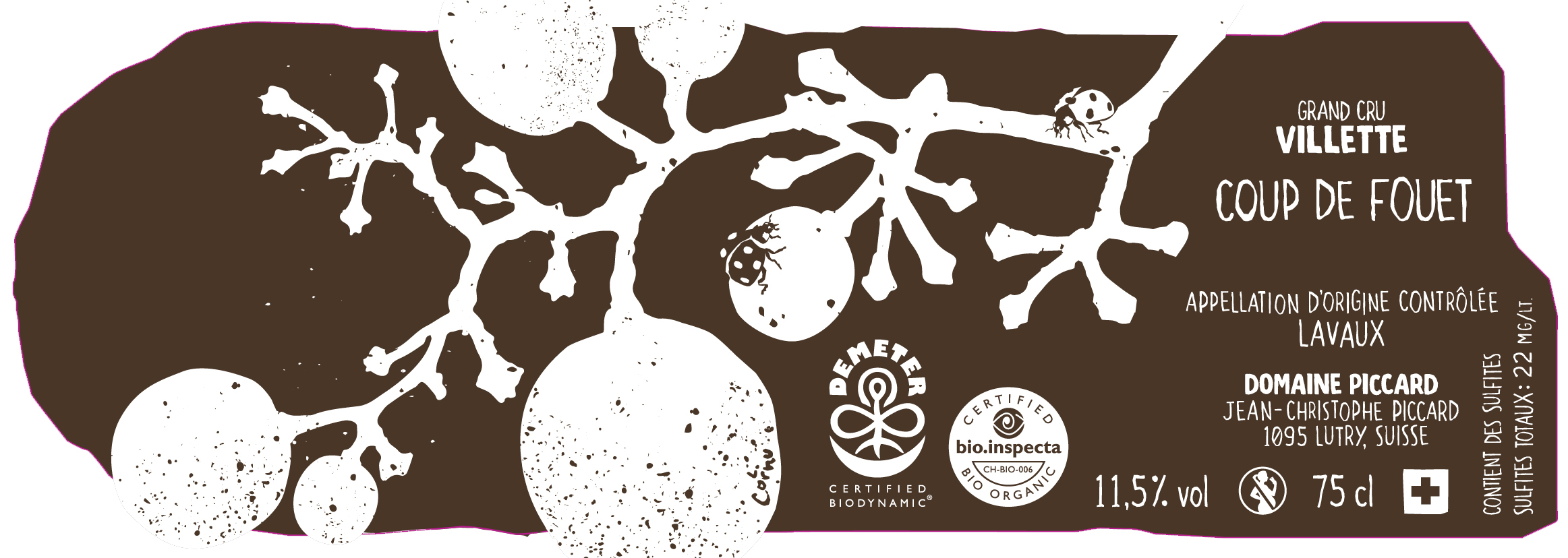
Coup de Fouet Villette Grand Cru AOC Lavaux
Vinification: A cuvée made “with the old”, i.e. high on its residues, and bottling without any filtration to alter the virtues of its soil. Therefore, the beautiful “juice”, unchaptalised, is from fermented, indigenous yeasts. This is a vinification most “pure”, without sulfite, at least until bottling.
Grape Variety: 100% Chasselas
Alcohol: 11.5%
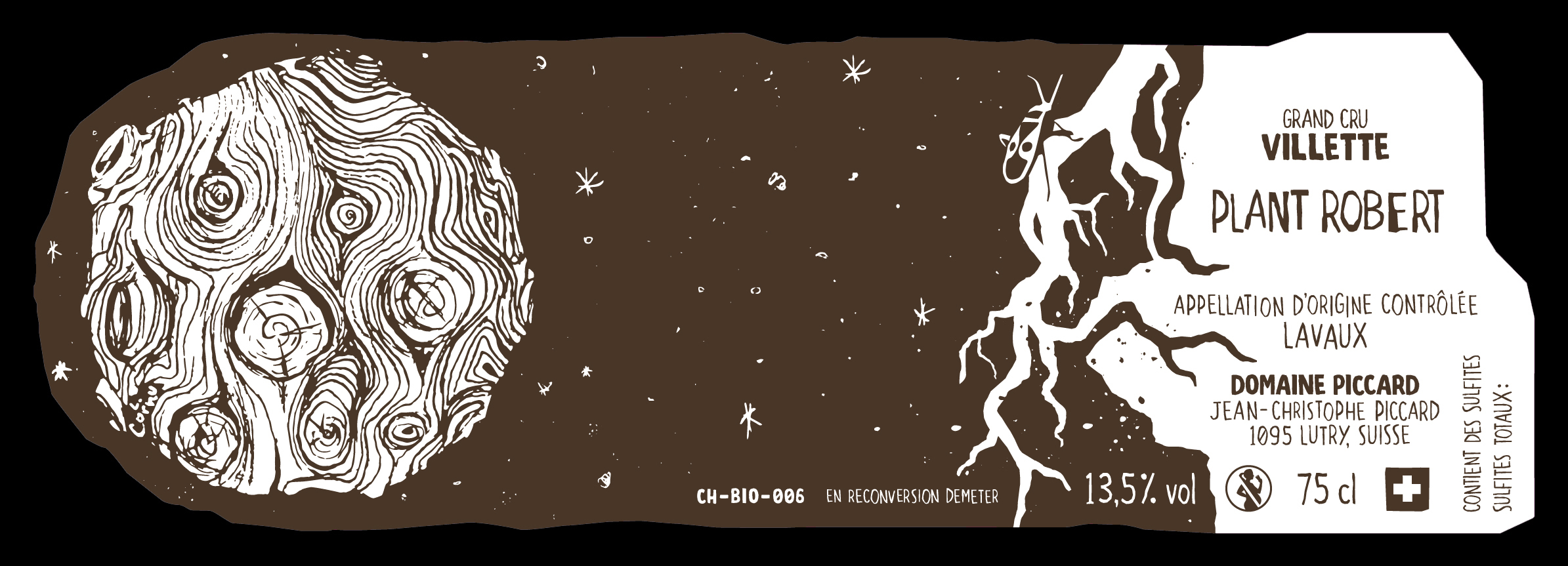
Plant Robert Villette Grand Cru AOC Lavaux
Grape Variety: Plant Robert (a biotype of Gamay) is a unique specialty of Lavaux. Less than a kilo of grapes per vine. Its beautiful grapes, slightly oblong, are reminiscent of barrels. But it is the subtle and spicy character of this grape variety that makes it original. How did it arrive in the area? The legend speaks of a vine that was “stolen” from its bearer, a Roman soldier… curious. What is certain is that Domaine Piccard planted this variety circa 1995. It is perhaps the most acclimatized red variety; the most regular of the vineyard. Good year, bad weather, severe weather or mild, it produces every year beautiful crops.
Vinification: All the wines are genuine artisanal products and are vinified and matured in the cellar located under the estate house. The winemaker’s philosophy is few interventions, but rigorous follow-up. Confidence in the natural mechanisms and virtues of the grapes is a valuable ally. Domaine Piccard believes that producing healthily, without the use of chemicals, is a noble goal. Above all, it is the only way to guarantee the long-term future of our health, and that of our Earth.
Aging: Long aging period (12 months) in French oak barrels. Rich in color, aging in the bottle (min. 18 months) highlights the elegant marriage of flavors and tannins, giving the Plant Robert its trademark, unique to the Lavaux.
Tasting Notes: A varietal of Lavaux, it expresses its Mediterranean aspect. Spicy and powerful scents, a light structure supported by the patience of being nurtured in barrels, finesse linked to subtle wanderings. An extra color to the palette of terrestrial crus.
Alcohol: 13.5%
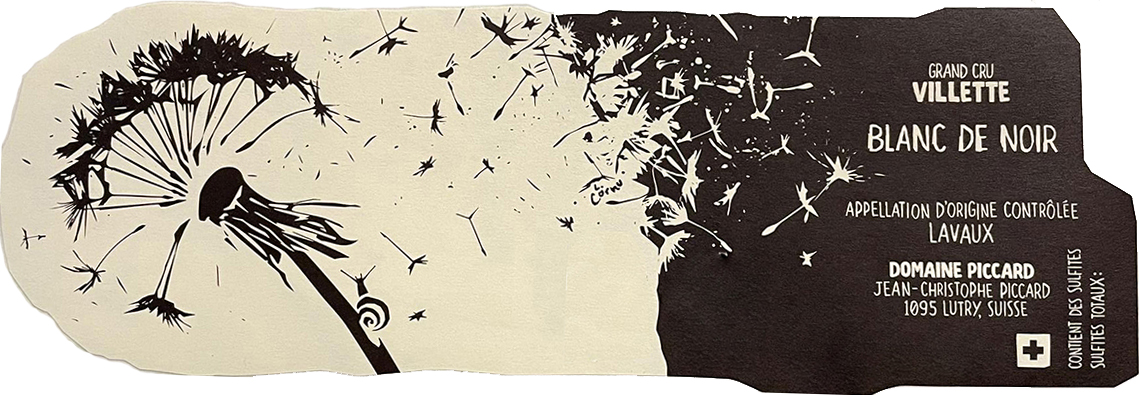
Blanc de Noir Villette Grand Cru AOC Lavaux
Grape Variety: Pinot Noir
Vinification: All the wines are genuine artisanal products and are vinified and matured in the cellar located under the estate house. The winemaker’s philosophy is few interventions, but rigorous follow-up. Confidence in the natural mechanisms and virtues of the grapes is a valuable ally. Domaine Piccard believes that producing healthily, without the use of chemicals, is a noble goal. Above all, it is the only way to guarantee the long-term future of our health, and that of our Earth.
Tasting Notes: This wine is a real novelty, packed with warmth and character while remaining fresh yet suave. Some residual sugars remain as well as a slight fizziness on the palate.
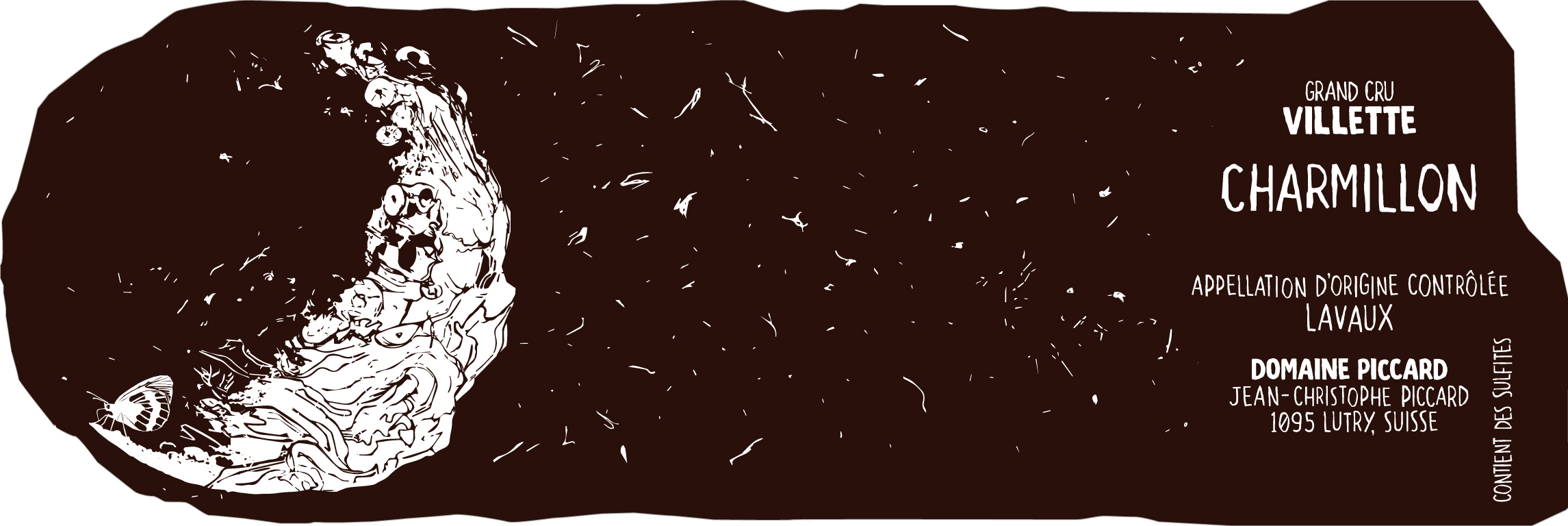
Charmillon Villette Grand Cru AOC Lavaux
Overview: This blend has been produced by Domaine Piccard since 1962. Charmillon highlights the first red grape varieties cultivated on their land: Pinot Noir & Gamay.
Grape Varieties: Pinot Noir, Gamay
Vinification: Long fermentation, more than 2 months. No added sulfur
Aging: In cellar for 36 months, some sulphites added.
Tasting Notes: Fleshy, well-balanced, with beautiful, fresh tannins. Floral & aromatic; expressive with subtle minerality.
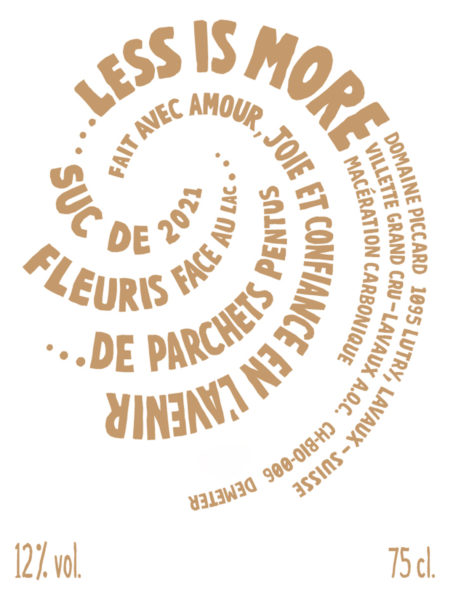
Less Is More Villette Grand Cru AOC Lavaux
Overview: “Less is More” is a full grape maceration orange wine composed of all the white varieties grown at the domaine. Harvested almost grape by grape, this wine is made from the grapes salvaged from a disastrous year which gave birth to an incredible wine…
Grape Varieties: Chasselas, Muscaris (a cross between the grapes Solaris (a white-skinned hybrid of Merzling and Geisenheim) and Muskateller (Muscat), with a good resistance to diseases), and a mix of Chardonnay, Marsanne, Gewurztraminer.
Tasting Notes: From the Domaine Piccard parcels came two carbonic maceration wines, including this incredible cuvée, made from all the white grapes of the Domaine. From these grapes, which have not been crushed or destemmed, is born a shimmering wine – slightly tannic with citrus flavors. No sulphites added.
Alcohol: 12.0%


